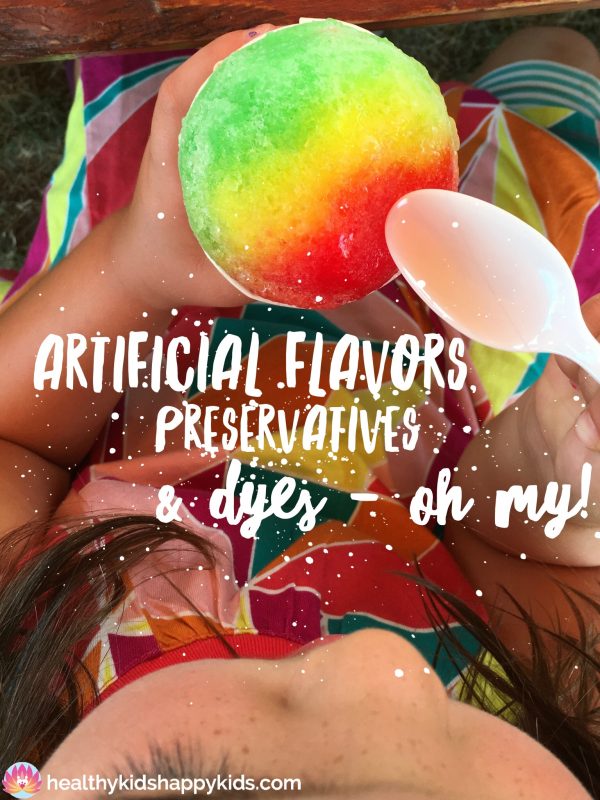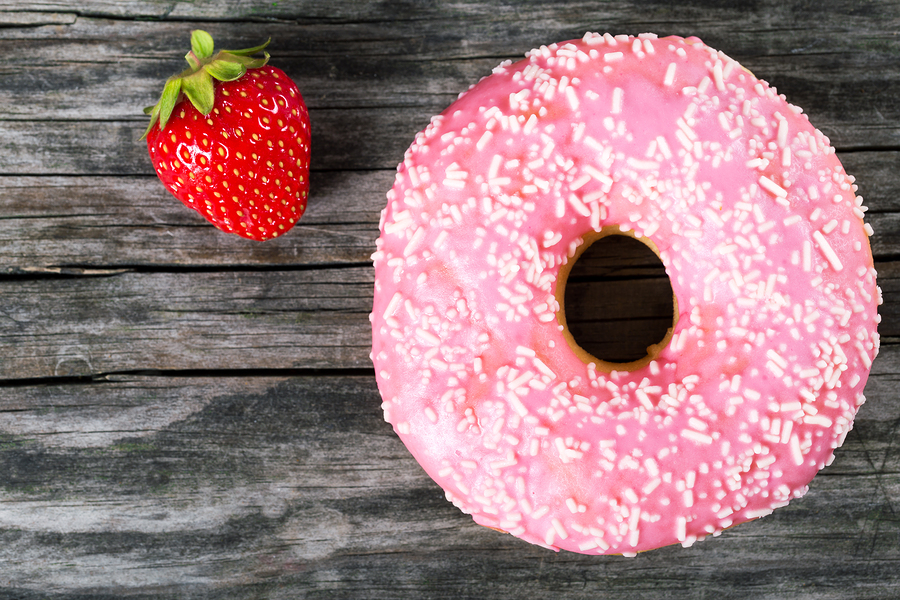
The summer is heating up, and your kid is begging for that neon-colored snow cone. Do you do it?
You’ve all heard the advice to take out the artificial junk in your kids’ diet and eat whole, organic, unprocessed foods. We’ve all embraced it – sort of. I mean, how bad can the occasional red Gatorade or bomb pop really be?
Uh – really bad. And if your kid has ADHD/ADD, focus and attention problems, sensory issues, behavioral challenges, mood swings, anxiety and depression, seizures, headaches, sleep problems, ANY neurologic issue – then Really REALLY BAD!
HOW BAD?
Way back in the 1970s, San Francisco allergist, Dr. Ben Feingold, found that food dyes and certain other natural and artificial components of foods caused hyperactivity and behavioral problems in children and adults1. For some kids, the “Feingold diet” – which eliminates all artificial flavors, dyes, and preservatives, and restricts foods high in naturally occurring compounds called salicylates and phenols – can be life-changing.
Kids with ADHD tell me that they feel in control of their bodies now. I’ve been able to help kids get off or stay off ADHD meds by changing their diet. When your usually sweet, calm child has total out-of-the-blue-throwing-kicking-screaming-hitting-who-is-this-child all out meltdowns that you can’t do anything about – that can be a thing of the past! All of a sudden, kids can stand and want hugs and kisses from their parents. All of a sudden, they can walk by their sister without body slamming her, or sit calmly in class without constantly tapping their pencil or poking at the kid next door.
WHAT’S THE EVIDENCE?
In 2011, the Food and Drug Administration (FDA) evaluated a ton of studies looking at the link between artificial food dyes and their relationship to behavioral disorders, and concluded that:
“Exposure to food and food components, including artificial food colors and preservatives, may be associated with adverse behaviors, not necessarily related to hyperactivity, in certain susceptible children with ADHD and other problem behaviors, and possibly in susceptible children from the general population.”2
Several studies have concluded that there IS a cause-and-effect relationship between artificial food dyes and hyperactivity or behavioral symptoms in sensitive children.3,4,5,6 Almost 1 in 10 kids with ADHD may have symptoms related to food dyes3, and almost 1 in 3 kids with ADHD may respond to a diet that eliminates artificial food dyes3,4. WAIT, let’s repeat that:
1 in 3 kids with ADHD might be helped simply by removing artificial food dyes in their diet!!!
A recent review in 20148 of all previous studies found that the harmful effects of artificial food colors were seen not just in kids with ADHD, but kids in general. This effect was possibly related to common genetic variations in histamine and dopamine metabolism, and to the depletion of certain minerals like zinc, which is essential for proper brain and immune function. Our daily consumption of artificial food colors as a nation has quadrupled in the last 50 years! This review concluded that the effect of this increased consumption of artificial food dyes by all kids “may conceivably be a possible deleterious effect on classroom climate from most children deteriorating slightly, thus additively or even synergistically impairing the learning atmosphere.”
OMG! If your kid with ADHD symptoms, behavioral problems, sensory issues – you name it – could get better by removing all artificial food dyes, wouldn’t you try it?
LET’S TRY SOMETHING
DON’T peek. Take a look at this list of ingredients, and guess what it is:
amyl acetate, amyl butyrate, amyl valerate, anethol, anisyl formate, benzyl acetate, benzyl isobutyrate, butyric acid, cinnamyl isobutyrate, cinnamyl valerate, cognac essential oil, diacetyl, dipropyl ketone, ethyl acetate, ethyl amyl ketone, ethyl butyrate, ethyl cinnamate, ethyl heptanoate, ethyl heptylate, ethyl lactate, ethyl methylphenylglycidate, ethyl nitrate, ethyl propionate, ethyl valerate, heliotropin, hydroxyphenyl-2-butanone (10 percent solution in alcohol), a-ionone, isobutyl anthranilate, isobutyl butyrate, lemon essential oil, maltol, 4-methylacetophenone, methyl anthranilate, methyl benzoate, methyl cinnamate, methyl heptine carbonate, methyl naphthyl ketone, methyl salicylate, mint essential oil, neroli essential oil, nerolin, neryl isobutyrate, orris butter, phenethyl alcohol, rose, rum ether, g-undecalactone, vanillin, and solvent

Give up? It’s FDA-approved “STRAWBERRY FLAVORING”!!! YUCK!!! When you get your kid a strawberry-flavored popsicle, this is probably what’s inside. Let’s break down some of the ingredients a little more:
- Amyl acetate: In addition to its use as a flavoring agent, amyl acetate is used as a paint and lacquer solvent.
- Benzyl isobutyrate: This is a common ingredient in fragrances. It is used in detergents, soaps and household products.
- Butyric acid: Again, a flavoring. A fatty acid; foul-smelling, with the odor of rancid butter. The smell may cause nausea. Used in making plastics and disinfectants. Harmful if inhaled. Corrosive.
- Dipropyl ketone: A flavoring. May cause coughing, sore throat, headaches, dizziness, vomiting. Used as a solvent for many resins.
- 4-Methylacetophenone: Another flavoring agent. Harmful if swallowed; irritating to the eyes. One of the nearly 600 additives in cigarettes
WHAT ABOUT NATURAL FLAVORS?
If you see anything that says “Artificial Flavors”, you may already be running away. But what if it says “Natural flavors”? Sounds great, right? It’s NATURAL! How the heck could it be bad for you?
Unfortunately, “Natural flavors” is often code word for MSG or other “natural” chemicals that can harm neurologic health. And “flavor” can mean just about anything. Not only that, the FDA doesn’t require manufacturers to list “incidental additives” on their food labels. So that means even “natural flavors” can include 100s of small amounts of distinct substances, including natural or artificial emulsifiers, solvents, and preservatives. Whoa! “Artificial” and “natural” flavors really aren’t that different.
Foods that are labeled “organic” and have natural flavors are probably better. For “organic foods,” the natural flavor must have been produced without synthetic solvents, carriers and artificial preservatives. But if a food was just “made with organic ingredients,” manufacturers have more leeway to use artificial ingredients and solvents.
Has the FDA really done anything to regulate artificial additives in our food and protect our kids health? NO! Since 2010, the European Union has required manufacturers to put a warning label on foods containing artificial food dyes that they “may have an adverse effect on activity and attention in children.”9 It’s time for the FDA to step up and do the same!

Did you know that several multi-national food corporations (McDonald’s, Kraft, PepsiCo, Kellogg’s, Betty Crocker, Mars) have 2 SEPARATE food lines? One for the US that uses artificial food additives like artificial food flavors, colors, and preservatives, and one for European markets that only uses real fruit and natural colors? The reason – because supposedly Americans have different taste and appearance standards. In February 2015, Nestle announced that it was going to remove artificial flavors and colors in candy, NOT due to concern for health risks, but due to consumer demand, and that they will not compromise on taste and appearance. Can I do a virtual eye roll now, please?!?!
SO, WHAT FOOD ADDITIVES SHOULD YOU AVOID?
Basic rule – READ LABELS.
If you can’t pronounce it, DON’T give it to your kids!
For more guidance, turn to the Environmental Working Group’s Dirty Dozen Guide to Food Additives. Some of these include:
- Nitrites and nitrates
- Potassium bromate
- Propyl paraben
- Butylated hydroxyanisole (BHA) and Butylated hydroxytoluene (BHT)
- Propyl gallate
- Theobromine
- “Natural flavors”, “Artificial flavor”, “Incidental additives”
- Monosodium glutamate
- Aspartame (Equal, NutraSweet)
- Acesulfame-K
- Olestra
- Sodium Nitrite or Sodium Nitrate
- Hydrogenated vegetable oil/trans fats
- Blues 1 and Blues 2
- Red 3
- Yellow 6
Of course, as soon as you see anything that says “artificial” – RUN! If it says “natural”, then take pause. And if it says “organic,” it’s possibly something to consider giving your kid.
BOTTOM LINE
- Stick to whole, organic, unprocessed foods as much as possible.
- Read labels.
- Avoid artificial flavors, colors and preservatives – pretty much anything you can’t pronounce.
- If your child has attention, focus, sensory, behavioral issues of any sort – stay tuned for more tips on how to help!
If you found this information useful, or know another parent or educator who would, then please do pass it on. It’s so important to get this information out there! And be sure to follow me on Facebook (www.facebook.com/DrElisaSongMD) and on Instagram (@healthykids_happykids) for more daily advice and adventures!
In health and happiness,
Elisa Song, MD
References:
- Feingold BF (1977) Behavioral disturbances linked to the ingestion of food additives. Delaware Medical Journal Feb;49(2):89-94,1977.
- FDA FAC (Food and Drug Administration Food Advisory Committee). “Overview and Evaluation of Proposed Association Between Artificial Food Colors and Attention Deficit Hyperactivity Disorders (ADHD) and Problem Behaviors in Children.” 2011. At http://www.fda.gov/downloads/AdvisoryCommittees/CommitteesMeetingMaterials/FoodAdvisoryCommittee/UCM273033.pdf
- Nigg JT, Lewis K, Edinger T, Falk M. “Meta-Analysis of Attention-Deficit/Hyperactivity Disorder or Attention-Deficit/Hyperactivity Disorder Symptoms, Restriction Diet, and Synthetic Food Color Additives.” Journal of the American Academy of Child & Adolescent Psychiatry 51(1): 86-97.e8, January 2012
- Sonuga-Barke EJ, Brandeis D, Cortese S, Daley D, Ferrin M, Holtmann M, et al. “Nonpharmacological Interventions for ADHD: Systematic Review and Meta-Analyses of Randomized Controlled Trials of Dietary and Psychological Treatments.” Amer J of Psychiatry. 2013 Mar 1; 170(3):275-89
- Schab DW, Trinh N-H T. “Do Artificial Food Colorings Promote Hyperactivity in Children with Hyperactive Syndromes? A Meta-Analysis of Double-Blind Placebo-Controlled Trials.” J Dev Behav Pediatr. 2004; 25:423-34.
- Stevenson J, Buitelaar J, Cortese S, Ferrin M, Konofal E, et al. “Research Review: The Role of Diet in the Treatment of Attention-Deficit/Hyperactivity Disorder – An Appraisal of the Evidence on Efficacy and Recommendations on the Design of Future Studies.” Journal of Child Psychology and Psychiatry. First published online, February 19, 2014.
- Editor’s note. “ADHD and Food Additives Revisited.” AAP Grand Rounds. 2008;19;17 DOI: 10.1542/gr.19-2-17.
- Arnold LE, Lofthouse N, Hurt E. “Artificial Food Colors and Attention-Deficit/Hyperactivity Symptoms: Conclusions to Dye for.” Neurotherapeutics, 2012; 9: 599-609.
- European Union. Regulation (EC) No 1333/2008 of the European Parliament and of the Council of 16 December 2008 on food additives. Available online. http://eurlex.europa.eu/LexUriServ/LexUriServ.do?uri=OJ:L:2008:354:0016:0033:en:PDF
Leave a Reply